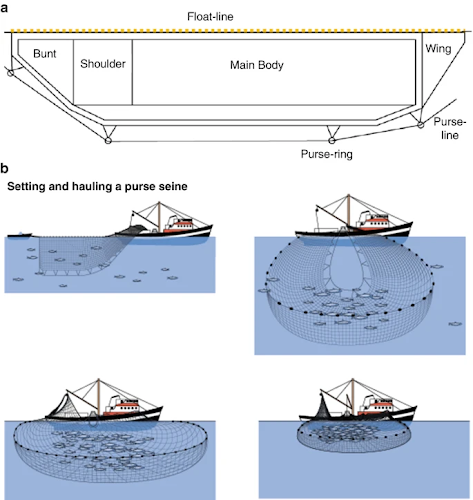Purse Seine Fishing
Why in the News?
The Centre has told the Supreme Court that a ban imposed by certain coastal States on purse seine fishing, which is known to disadvantage endangered species, is not justified.
What are the Issues?
- Currently, bans on purse seine fishing are implemented in the territorial waters of Tamil Nadu, Kerala, Puducherry, Odisha, Dadra and Nagar Haveli and Daman and Diu, and the Andaman and Nicobar Islands up to 12 nautical miles.
- States such as Gujarat, Andhra Pradesh, Goa, Karnataka, West Bengal have not imposed any such ban.
What is Purse Seine Fishing?
- About:
- A purse seine consists of a long wall of netting that is supported by floating and leadline and has purse rings hanging from the lower edge of the gear. A purse line composed of steel wire or rope goes through the purse rings and allows the net to be pulled through.
- The western shores of India have seen extensive use of the technology.
- Advantages:
- Purse-seine fishing in open water is considered to be an efficient form of fishing.
- It has no contact with the seabed and can have low levels of by catch.
- It can also be used to catch fish congregating around fish aggregating devices
- It is used in the open ocean to target dense schools of single-species pelagic (midwater) fish like tuna and mackerel.
What are the Concerns?
- In some States, this technique linked to concerns about the decreasing stock of small, pelagic shoaling fish such as sardines, mackerel, anchovies and trevally on the western coasts.
- The scientific community argues that climatic conditions, including the El Nino phenomenon, are responsible for the declining catch of such fish in the last ten years.
- However, fishermen using traditional methods have placed the blame squarely on the rise of purse seine fishing, and fear a further fall in the availability of these small fish if the ban is lifted.
- They have also demanded that, as the Centre has supported the lifting of the ban, it should publish the expert committee report it has based its stance on.
- A major concern is the dwindling availability of oil sardines, a favourite of Kerala fish eaters.
- In 2021, Kerala recorded a catch of just 3,297 tonnes of sardine, a sharp decrease from the haul of 3.9 lakh tonnes in 2012.
- Purse seine is a non-targeted fishing gear and catches all sorts of fishes which come in the way of the net, including juveniles. Hence, they are very much detrimental to marine resources.
What is the Union Government’s Argument Against Ban?
- According to a study provided by an expert group, the Union Ministry of Fisheries, Animal Husbandry, and Dairy has proposed easing the restriction on purse seine fishing.
- According to the expert panel, “given the existing facts, this mode of fishing per se has not resulted in any severe resource loss so far.”
- Under specific restrictions, the expert panel has advised using purse seineiners to fish in territorial seas and the Indian Exclusive Economic Zone (EEZ).
- Additionally, the committee has recommended that a “national management plan on purse seine fisheries” be created.
What is the Jurisdiction of Fishing?
- Fishing is a governmental responsibility, and the State is responsible for the administration of marine fisheries in territorial seas.
- There are 61 subjects in a state subject (originally 66 subjects).
- Local issues of importance include local governance, law enforcement, public health and sanitation, agriculture, forestry, fisheries, education, and state taxes and charges. Under normal circumstances, the states alone have the authority to enact legislation on the topics listed in the State List.




